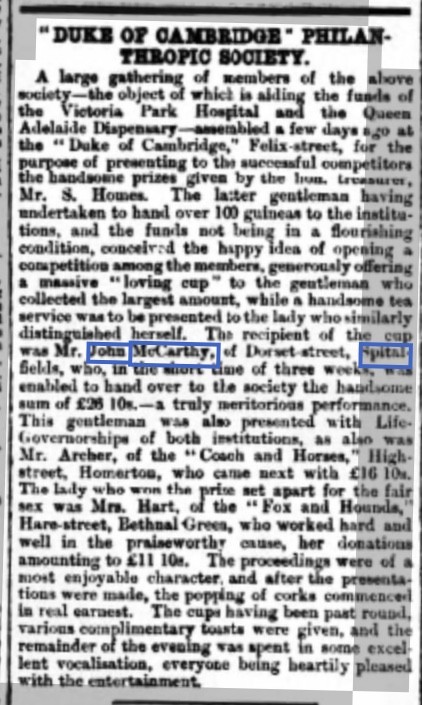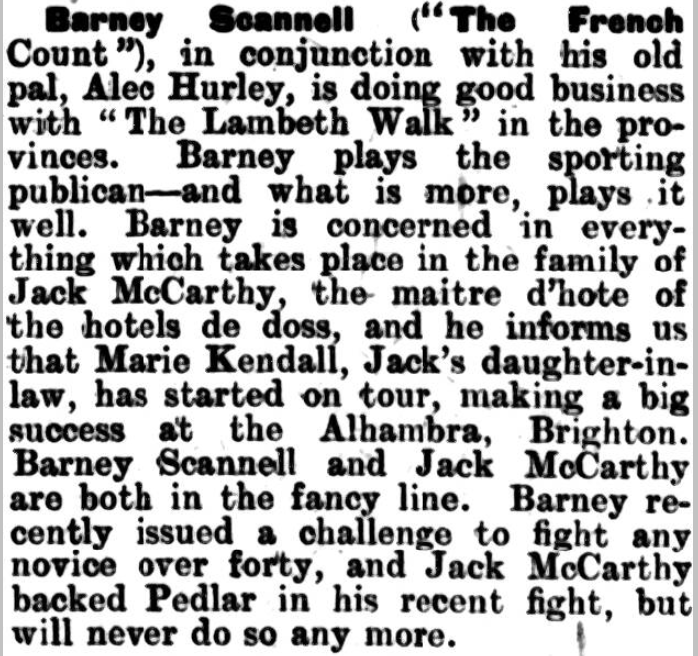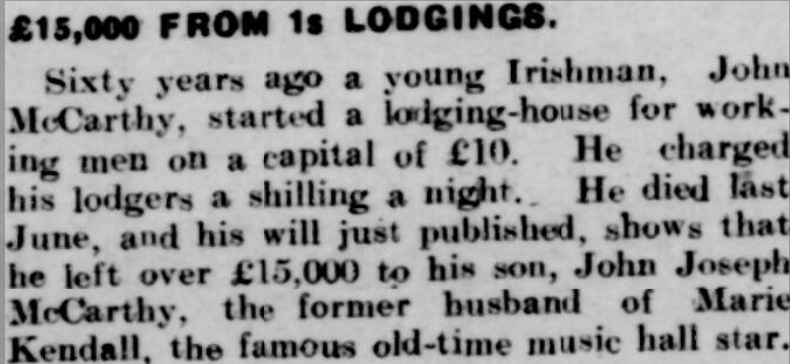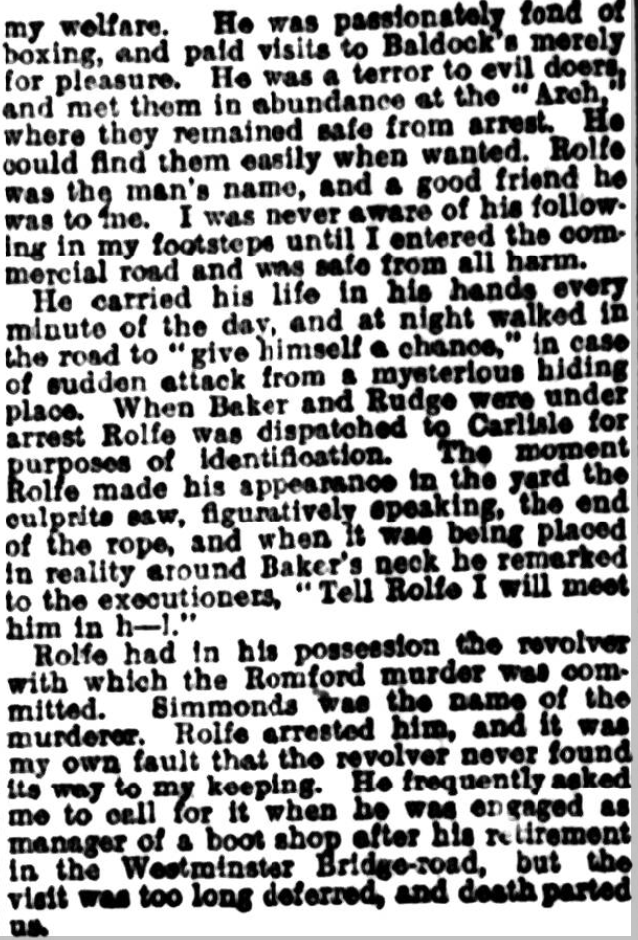Originally posted by MrBarnett
View Post
John McCarthy
Collapse
X
-
If you read the pamphlet issued to counter Fred McKenzie’s characterisation of Dorset Street as the ‘Worst Street in London’, you’ll see reference made to a ‘Mr J. McCarthy sen.’ The use of ‘sen’ suggests there was a similarly prominent ‘J. McCarthy jun.’, which of course there was - ‘Steve’, the entertainer.
The two Dorset Street JMs were often mentioned in tandem as ‘sen.’ and ‘jun’. Perhaps there was another prominent JM father and son combo who supported local good causes alongside men named Crossingham, Cooney, Tempany etc.
You never know.
Comment
-
I’ve just started a thread over At Howard’s gaff which may complement this one:
I came across the photo below in an online article about the Chinese in Limehouse. It is labelled: circa 1924: A Chinese shop in Pennyfields, East London. (Photo by Keystone/Getty Images) But look at the tramlines - did trams ever run down Pennyfields? I very much doubt it, it was too narrow. The image is of a much broader
Comment
-
Hi,
Is there another coincidence here, The Wringers/Ringers, are from Norfolk, They had The Britannica in Dorset street The Norfolk letter sent to the police a week before Millers court, stated I shall be at work between the two piers, These are The Britannica , and The Wellington[ another Whitechapel pub,] Also Further down Dorset street the letter alleged was penned from.
My nose is twitching,
Regards Richard,
Comment
-
If you like we can ride the coincidences of the Yarmouth letter. It was reported to have said to look out for Jack the Ripper at either of the piers where he intends to do for two Norwich women before closing time. The piers at Yarmouth are known as the Britannia and the Wellington. There was a Britannia at the bottom of Dorset Street and a Duke of Wellington. The term ‘closing time’ is commonly associated with a pub. Mary Kelly was sighted at the Britannia on her last night.Originally posted by richardnunweek View PostHi,
Is there another coincidence here, The Wringers/Ringers, are from Norfolk, They had The Britannica in Dorset street The Norfolk letter sent to the police a week before Millers court, stated I shall be at work between the two piers, These are The Britannica , and The Wellington[ another Whitechapel pub,] Also Further down Dorset street the letter alleged was penned from.
My nose is twitching,
Regards Richard,
The Gehringers ran ‘The City of Norwich’ on Wentworth Street. 18 George Street may have been run by them in 1885/ 86 but Daniel Lewis was running it by 1888. Mary Kelly did live for a time in George Street. Could a ‘Norwich woman’ be a term for ‘Gehringer woman’? Had Kelly been in some sense a ‘Norwich woman’? It’s odd to point out specifically ‘Norwich’ women when supposed to be out and about in Yarmouth.
If Mary Kelly was a ‘Norwich woman’ by virtue of having ‘worked’ for the Gehringers, then Emma Smith the first of the Whitechapel Murder victims would have been. She was resident at 18 George Street. She was attacked on/ near the street corner of Wentworth Street one block away from The City of Norwich. Martha Tabram may also have been a former ’Norwich woman’, she was also a resident of George Street. She was attacked in the alley directly in front of the City of Norwich.
The last place Polly Nichols was seen alive was at the junction of Osborn Street and Whitechapel High Street, outside Feldman’s Post Office. Also close to the City of Norwich.
The City of Norwich appears again in relation to Jacob Isenschmid, a suspect in the murder of Polly Nichols and Annie Chapman. His wife said he was a regular there, Mrs Gehringer when questioned denied this.
Going back to the letter, it was unstamped. When a letter is unstamped, either the recipient agrees to pay the postage or the letter is returned to sender. The letter could have ended up delivered to 14 Dorset Street.
The Chief Constable of Yarmouth in 1888 was William Brogdon. His son, also William Brogdon was at one time a Detective in H Division. He may have been there in 1888. The author may have known this and may have thought the message could get back to Dorset Street by that route.
14 Dorset Street may have been intended as the recipient of letter. It may have been a threat.
In 1898, McCarthy was described by Duckworth as controlling the area centred on Dorset Street and Gehringer controlling the area centred on Great Pearl Street. Perhaps they were rivals. In 1888, Yarmouth could be a ‘code’ for Dorset Street, Norwich could be a ‘code’ for the City of Norwich and its associates.
An intriguing set of coincidences and suppositions, but maybe it's just that. Coincidence.
Comment
-
Thomas Hewington was not the first Thomas to be remanded for this murder. The original suspect was a young man named Thomas McCarthy.Originally posted by seanr View Post
A few more details on the Alec Munro 'accident' found by Grappling with History https://twitter.com/wrestling1880s/s...09192275890181 (the forthcoming book on Munro and Ching Hook looks cool).
It seems Munro was resident at 6 Great Pearl Street, a Gehringer owned lodging house, and he went into the kitchen at a McCarthy owned lodging house and ended up falling accidentally onto a knife held in the hand to Thomas Hewington. Both McCarthy's employee John Williams and Gehringer himself endorse the view this was a tragic accident.
As Frederick Dinger [sic] said in his trial testimony:
All very plausible I'm sure. Thomas Hewington found not guilty of any crime even manslaughter, it appears.
John McCarthy was already a pretty big deal in the boxing world by this time. The Gehringer's weren't involved yet, not officially but there had been a boxing ring set up at the City of Norwich in 1882 for assualt at arms by the East London Amateur Athletic Club but the event was postponed on police advice, boxing did not resume at the City of Norwich until 1888, when Alec Munro's protege Ching Ghook was managing public sparring competitions there.
6 Little Pearl Street was a lodging house owned by a (the?) John McCarthy.
It was very lucky for young Thomas McCarthy that Detective Sergeant Rolfe was able to produce so many witnesses so quickly who would state it was not him who had stabbed the man. Such a shame, as Mr Hannay commented on strongly, that no-one saw fit to take a statement from the injured Munro before he died!
Gosh, I wonder if it could be known to us whether Detective Sergeant Rolfe had had a (business) connection to the John McCarthy a number of years before this incident.

Comment
-
No problem, Sean. Any thoughts on the John McCarthy who lived at 27 Dorset St. in 1891? He was a general shop keeper, aged 42 with a wife, Mary and a son, George?
RG12/274/130/p. 12
Comment
-
I have no opinion what-so-ever on that gentlemen. As the name McCarthy appears to have been very common amongst the Irish population in the East End of the time, it’s possible he was just a lodger or a relation of the other more famous John McCarthy.Originally posted by Scott Nelson View PostNo problem, Sean. Any thoughts on the John McCarthy who lived at 27 Dorset St. in 1891? He was a general shop keeper, aged 42 with a wife, Mary and a son, George?
RG12/274/130/p. 12
The local police certainly stuck their neck out for John McCarthy the witness, going so far as to make statements to the press that he was a most respectable man. This being said despite John McCarthy’s premises being used for a criminal enterprise on the morning of the 9th of November 1888. This is from Newcastle Daily Chronicle - Saturday 10 November 1888, page 4.

Newcastle Daily Chronicle - Saturday 10 November 1888
The police additionally point out that the witness is the same man who was recently awarded a prize for collecting money from the hospitals.
We now know that the money raised for the hospitals came from an Assault at Arms event at the St James Tavern in Duke’s Place, close to Mitre Square in December 1885. It is rumoured elsewhere that the diamond magnate and local son Barney Barnato was present at this event. Barney Barnato had been a keen boxer in his youth and regularly returned to Spitalfields from Kimberley, South Africa during Jewish holidays. Barney Barnato’s birth name had been Barney Isaacs, and had performed in the music halls with his brother Harry Isaacs prior to going to Kimberly and starting their great diamond adventure (and very great it was, Barnato went from being penniless to being one of the richest men in the world). The H.Isaacs fighting here might possibly be the older brother Harry Isaacs.

Sporting Life - Tuesday 08 December 1885

East London Observer - Saturday 30 January 1886
All this is a long-winded way of saying, the witness who appeared as the landlord at the Mary Kelly inquest, I am certain is the same man as the boxing promoter.
Comment
-
The East London Observer from Saturday 30 November 1878 contains a story about the boxing match between Henry Fenning and Dan McCarthy under an arch in Station Place in Shadwell.
This fight was an illegal fight and I’ve reason to believe that there was gambling taking place on the outcome of the match, all of which would have been criminal offences under the law of the time.
The unnamed correspondent who wrote this article records that the event was patronised by several plain clothes members of the Police.

East London Observer - Saturday 30 November 1878, page 6
The Illustrated Police News from Saturday 09 July 1904, contains what was the first of three parts writing about the the infamous Prize in the Chapel which notes the author’s belief that organisers of this fight had intended on ‘tapping the pockets’ of the unwary, meaning pick pocketing. Maybe more on this historic fight later.
Organising to pick the pockets of the punters at the illegal fight you'd arranged would be a potentially lucrative criminal enterprise.

Illustrated Police News - Saturday 09 July 1904, page 12
An underground boxing event hosting an illegal fight, was a lucrative location for organised crime with the opportunity it created to profit from pickpocketing and illegal gambling. Such events seem therefore to have been criminal enterprises and so does not seem like the kind of events that serving Police officers should be attending or certainly not moonlighting at as security.
I’m not sure what the law on this would have been in 1878, but Police moonlighting as security for a criminal enterprise would be unlikely to be approved of by the force today. Perhaps they police the unnamed correspondent mentioned were just attending in a recreational capacity. It’d be worrying if anyone from H Division could be described as acting as private security for this unlawful event, wouldn’t it?
I do wonder if we know any of the names of the Police who attended the fights at Jack Baldock’s East End Gymnasium?
Comment
-
But how certain are you? Did the boxing promoter own Millers Court? Or did he just supply wholesale grocery goods to his shop on the ground floor of #27?Originally posted by seanr View PostAll this is a long-winded way of saying, the witness who appeared as the landlord at the Mary Kelly inquest, I am certain is the same man as the boxing promoter.
Comment
-
There's a boxing promoter named J. McCarthy who arranged a boxing event at the Duke's Tavern, in Duke's Place in December 1885 to raise funds for the Victoria Park Hospital. Then a John McCarthy of Dorset Street, Spitalfields winning a 'loving cup' for raising funds for the Victoria Park Hospital in January 1886.Originally posted by Scott Nelson View Post
But how certain are you?
Then the landlord of Mary Kelly in Dorset Street, Spitalfields described by Police in November 1888 as having 'recently' been awarded a prize for raising funds for the hospitals.
In the late 1890s and early 1900s a series of boxing events staged at Paddington Baths named Messrs Harry Lee and Jack McCarthy, Jun Grand Boxing Entertainments, where tickets could be obtained by purchasing them from Jack McCarthy at 27 Dorset Street.
Sporting Life - Thursday 09 February 1899
And a Jack McCarthy, described as the Maitre d'Hote of the Hotels de Doss, who is a boxing promoter and father-in-law of Marie Kendall in the Boxing World and Mirror of Life - Wednesday 12 March 1902.

Boxing World and Mirror of Life - Wednesday 12 March 1902.

Galway Observer - Saturday 18 August 1934
I'm pretty confident.
Who cares? Why does it matter?Originally posted by Scott Nelson View Post
Did the boxing promoter own Millers Court?
What's your evidence base that the John McCarthy, the general shop keeper, aged 42 with a wife, Mary and a son, George is the witness? When did he win a prize for collecting funds for the hospitals? - Got any references like at... all...
He was a very busy man, so he certainly did more than that. He's described by one source in 1911 as a household name in the East End who has backed more fighters than any man living, a Life Governor of many hospitals who was awarded a silver cup for raising funds for the hospitals years ago having staged a boxing entertainment at Duke's Place where Barney Barnato officiated as referee and all the funds going to the Victoria Park Hospital, as a chairman of many Dock Societies, and the benefactor of many who fall on hard times in the East End. This John McCarthy did so much more than supplying wholesale goods.Originally posted by Scott Nelson View Post
Or did he just supply wholesale grocery goods to his shop on the ground floor of #27?
Comment
-
Where does "the landlord of Mary Kelly in Dorset Street, Spitalfields" quote come from? As I've already said, sportsman Jack McCarthy owned a grocer's business on the ground floor of 27 Dorset Street. He wasn't the landlord of Millers Court and didn't collect the rents. His brother Daniel likely informed the 1891 census enumerator that Jack, his wife and daughters lived there because he owned the grocer's business and occasionally stopped by to resupply goods. The other John McCarthy was the shop keeper and collected the rents.Originally posted by seanr View Post
There's a boxing promoter named J. McCarthy who arranged a boxing event at the Duke's Tavern, in Duke's Place in December 1885 to raise funds for the Victoria Park Hospital. Then a John McCarthy of Dorset Street, Spitalfields winning a 'loving cup' for raising funds for the Victoria Park Hospital in January 1886.
Then the landlord of Mary Kelly in Dorset Street, Spitalfields described by Police in November 1888 as having 'recently' been awarded a prize for raising funds for the hospitals.
In the late 1890s and early 1900s a series of boxing events staged at Paddington Baths named Messrs Harry Lee and Jack McCarthy, Jun Grand Boxing Entertainments, where tickets could be obtained by purchasing them from Jack McCarthy at 27 Dorset Street.
Comment
-
In his statement to the Central News which must have been made on the 9th of November 1888, a copy of which is available in Newcastle Evening Chronicle - Saturday 10 November 1888, page 3 it is stated that he was the owner of the houses in Miller's Court and that he had sent Bowyer to collect the rents. It is this man who the police say won a prize for raising money for the hospitals. John McCarthy, the sportsman, won a prize for raising money for the hospitals.
His brother Daniel lied about John McCarthy the sportsman living at 27 Dorset Street because the sportsman occasionally popped in to resupply goods. Is this a serious suggestion? And the evidence of any of this would be?
The John McCarthy who was arrested for his part in the famous 'Prize Fight in Chapel' in 1882, was described as a General Shop Keeper of 27 Dorset Street, Spitalfields (East London Observer, 1 April 1882). Which John McCarthy was this? - perhaps the other John McCarthy also promoted illegal boxing matches and separately won a prize for raising funds for the hospitals.
Quite the coincidence two John McCarthys at the same address on the census, both of whom promoted boxing matches and both of whom won prizes for raising funds for the hospitals. Except for one of them we have the record of the boxing event the funds were raised at and the prize being awarded. And the evidence for your claims is, well, what exactly?
Comment
-
In the Empire News & The Umpire - Sunday 11 September 1910, Boxing referree and Sporting Life reporter Robert Patrick Watson writes of his memories of the boxing at the old Arch at Shadwell.

And he names one of the officers who was in attendance.

Rolfe was the man's name. The same Rolfe who apprehended Baker and Rudge, and who investigated the 'Romford murder'.
Comment


Comment